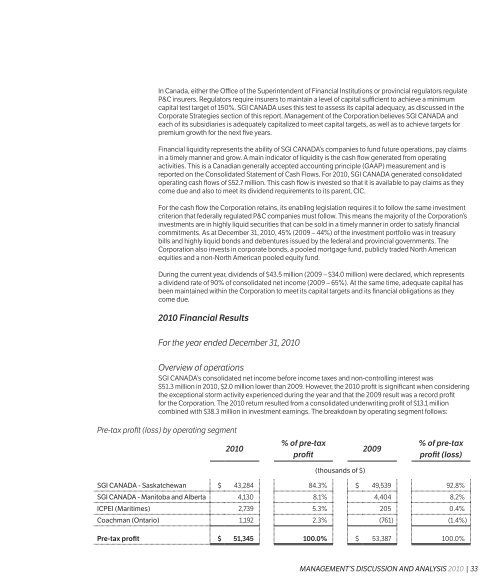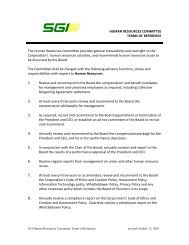Full report - SGI Canada
Full report - SGI Canada
Full report - SGI Canada
Create successful ePaper yourself
Turn your PDF publications into a flip-book with our unique Google optimized e-Paper software.
Notes to the consolidated financial statements<br />
December 31, 2010<br />
1. Nature of Operations<br />
Saskatchewan Government Insurance (the Corporation or <strong>SGI</strong>), which operates under the trade name of<br />
<strong>SGI</strong> CANADA, conducts a property and casualty insurance business in the province of Saskatchewan and<br />
in other provinces of <strong>Canada</strong> through its wholly-owned subsidiary <strong>SGI</strong> CANADA Insurance Services Ltd.<br />
<strong>SGI</strong> CANADA Insurance Services Ltd. operates directly in Alberta and Manitoba, in Ontario through its<br />
wholly-owned subsidiary Coachman Insurance Company (Coachman) and in Prince Edward Island, New<br />
Brunswick and Nova Scotia through its 75%-owned subsidiary, The Insurance Company of<br />
Prince Edward Island (ICPEI).<br />
In many provinces in <strong>Canada</strong>, automobile insurance premium rates are regulated by provincial government<br />
authorities. Regulation of premium rates is based on claims and other costs of providing insurance<br />
coverage, as well as projected profit margins. Regulatory approvals can limit or reduce premium rates that<br />
can be charged, or delay the implementation of changes in rates. The Corporation’s automobile premiums<br />
are subject to rate regulation in Alberta, Ontario, Prince Edward Island, New Brunswick and Nova Scotia<br />
and represent approximately 13.8% (2009 – 11.9 %) of the Corporation’s consolidated net premiums<br />
earned.<br />
<strong>SGI</strong> was established as a branch of the Public Service by The Government of Saskatchewan Act, 1944,<br />
reorganized pursuant to The Saskatchewan Government Insurance Act, 1946, and continued under the<br />
provisions of The Saskatchewan Government Insurance Act, 1980. <strong>SGI</strong> also acts as administrator of the<br />
Saskatchewan Auto Fund under the provisions of The Automobile Accident Insurance Act. As a provincial<br />
Crown corporation, <strong>SGI</strong> is not subject to federal or provincial income taxes, however <strong>SGI</strong> CANADA<br />
Insurance Services Ltd., Coachman and ICPEI are subject to federal and provincial income taxes.<br />
As a subsidiary of Crown Investments Corporation of Saskatchewan (CIC), the consolidated financial<br />
results of the Corporation are included in the consolidated financial statements of CIC.<br />
2. Significant Accounting Policies<br />
The accounting policies of the Corporation are in accordance with Canadian generally accepted<br />
accounting principles (GAAP).<br />
In March 2009, the Canadian Accounting Standards Board reconfirmed that Canadian GAAP for publicly<br />
accountable enterprises, including Government Business Enterprises (GBEs), will be replaced by<br />
International Financial Reporting Standards (IFRS) for interim and annual financial statements relating<br />
to fiscal years beginning on or after January 1, 2011. Accordingly, these financial statements will be the<br />
last prepared by the Corporation as a GBE under pre-conversion Canadian GAAP, and the conversion to<br />
IFRS will be applicable to the Corporation’s <strong>report</strong>ing for the first quarter of 2011, for which current and<br />
comparative information will be prepared under IFRS. The Corporation will also present an opening IFRS<br />
statement of financial position as at January 1, 2010, the Corporation’s date of transition, as part of the<br />
Corporation’s 2011 interim and annual financial statements.<br />
The following are considered to be the Corporation’s significant accounting policies:<br />
Consolidation<br />
The consolidated financial statements include the accounts of the Corporation and the consolidated<br />
accounts of its 100%-owned subsidiaries, <strong>SGI</strong> CANADA Insurance Services Ltd. and Coachman and its<br />
75%-owned subsidiary, ICPEI. All inter-company accounts and transactions have been eliminated on<br />
consolidation.<br />
Measurement uncertainty<br />
The preparation of financial statements in accordance with Canadian GAAP requires management to<br />
make estimates and assumptions that affect the <strong>report</strong>ed amounts of assets and liabilities, and disclosure<br />
of contingent assets and liabilities at the date of the financial statements and the <strong>report</strong>ed amounts of<br />
revenues and expenses during the <strong>report</strong>ing period. Actual results could differ from these estimates.<br />
Changes in estimates are recorded in the accounting period in which they are determined. The most<br />
significant estimation processes are related to the actuarial determination of the provision for unpaid<br />
claims (note 8), investment valuation (note 5), income taxes (note 12) and employee future benefits (note 16).<br />
Financial assets and liabilities<br />
The measurement basis for financial assets and financial liabilities depends on whether the financial<br />
assets and liabilities have been classified as held for trading, available for sale, held to maturity, loans<br />
and receivables or other financial liabilities. Financial assets and liabilities classified as held for trading<br />
are measured at fair value. Those changes in fair value are recognized in net income. Financial assets<br />
classified as available for sale are measured at fair value with unrealized changes in fair value recorded<br />
in other comprehensive income; however, unrealized losses considered other than temporary continue<br />
to be recognized as a decrease to net income. Financial assets designated as held to maturity, loans and<br />
receivables or other financial liabilities are measured at amortized cost using the effective interest method.<br />
The Corporation has no financial assets and liabilities designated as held for trading or held to maturity.<br />
The Corporation has designated its cash and cash equivalents and its investments as available for sale,<br />
except for investments accounted for on the equity basis, which are exempt from the above requirement.<br />
Accounts receivable are designated as loans and receivables. Accounts payable, dividend payable and<br />
premium taxes payable are designated as other financial liabilities. The net investment in capital lease,<br />
the accrued pension asset, unpaid claims recoverable from reinsurers, amounts due to reinsurers and the<br />
provision for unpaid claims are exempt from the above requirement.<br />
Investments<br />
All investments are carried at fair value, except preferred shares and investments accounted for on the<br />
equity basis. The fair value of short-term investments is based on cost, which approximates fair value<br />
due to the immediate or short-term nature of these financial instruments. The fair value of bonds and<br />
debentures and common shares is determined using quoted market values based on the latest bid prices.<br />
The fair value of pooled equity funds is based on the quoted market values of the underlying investments,<br />
which is based on the latest bid prices. The fair value of the pooled mortgage fund is based on the<br />
market values of the underlying mortgage investments, calculated by discounting scheduled cash flows<br />
through to the estimated maturity of the mortgage using interest rates that reflect the term and credit risk<br />
associated with the mortgage.<br />
Preferred shares are carried at cost as the fair value cannot be estimated reliably. Investments accounted<br />
for on the equity basis are recorded using the equity method, whereby the Corporation’s investment is<br />
adjusted for its share of the investee’s net earnings or losses and reduced by dividends received.<br />
The Corporation records its investment purchases and sales on a trade-date basis, which is the date when<br />
the transactions are entered into.<br />
Investment earnings<br />
The Corporation recognizes interest, premium financing and capital lease revenue as earned, dividends when<br />
declared, pooled fund revenue when a distribution is declared, and investment gains and losses when realized.<br />
Interest revenue includes amortization of any premium or discount recognized as of the date of purchase<br />
of the security. Amortization is calculated using the effective interest method. Realized gains and losses<br />
represent the difference between the amounts received through the sale of investments and their<br />
respective cost base. Interest is generally receivable on a semi-annual basis.<br />
66 | 2010 NOTES TO THE CONSOLIDATED FINANCIAL STATEMENTS NOTES TO THE CONSOLIDATED FINANCIAL STATEMENTS 2010 | 67















